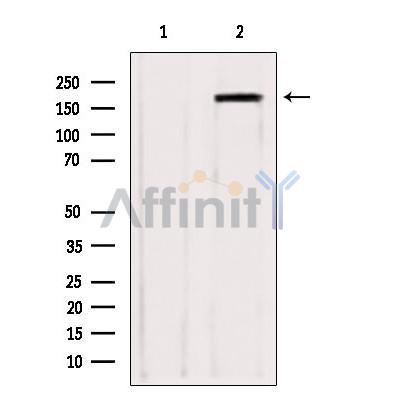ZCCHC11 Antibody - #DF12183
製品説明
*The optimal dilutions should be determined by the end user. For optimal experimental results, antibody reuse is not recommended.
*Tips:
WB: For western blot detection of denatured protein samples. IHC: For immunohistochemical detection of paraffin sections (IHC-p) or frozen sections (IHC-f) of tissue samples. IF/ICC: For immunofluorescence detection of cell samples. ELISA(peptide): For ELISA detection of antigenic peptide.
引用形式: Affinity Biosciences Cat# DF12183, RRID:AB_2844988.
折りたたみ/展開
DKFZp779C1943; EC 2.7.7.52; FLJ42878; KIAA0191; PAP associated domain containing 3; PAPD3; Terminal uridylyltransferase 4; TUT4; TUT4_HUMAN; TUTase 4; ZCCHC 11; Zcchc11; Zinc finger CCHC domain containing 11; Zinc finger CCHC domain containing protein 11; Zinc finger CCHC domain-containing protein 11;
免疫原
A synthesized peptide derived from human ZCCHC11, corresponding to a region within the internal amino acids.
- Q5TAX3 TUT4_HUMAN:
- Protein BLAST With
- NCBI/
- ExPASy/
- Uniprot
MEESKTLKSENHEPKKNVICEESKAVQVIGNQTLKARNDKSVKEIENSSPNRNSSKKNKQNDICIEKTEVKSCKVNAANLPGPKDLGLVLRDQSHCKAKKFPNSPVKAEKATISQAKSEKATSLQAKAEKSPKSPNSVKAEKASSYQMKSEKVPSSPAEAEKGPSLLLKDMRQKTELQQIGKKIPSSFTSVDKVNIEAVGGEKCALQNSPRSQKQQTCTDNTGDSDDSASGIEDVSDDLSKMKNDESNKENSSEMDYLENATVIDESALTPEQRLGLKQAEERLERDHIFRLEKRSPEYTNCRYLCKLCLIHIENIQGAHKHIKEKRHKKNILEKQEESELRSLPPPSPAHLAALSVAVIELAKEHGITDDDLRVRQEIVEEMSKVITTFLPECSLRLYGSSLTRFALKSSDVNIDIKFPPKMNHPDLLIKVLGILKKNVLYVDVESDFHAKVPVVVCRDRKSGLLCRVSAGNDMACLTTDLLTALGKIEPVFIPLVLAFRYWAKLCYIDSQTDGGIPSYCFALMVMFFLQQRKPPLLPCLLGSWIEGFDPKRMDDFQLKGIVEEKFVKWECNSSSATEKNSIAEENKAKADQPKDDTKKTETDNQSNAMKEKHGKSPLALETPNRVSLGQLWLELLKFYTLDFALEEYVICVRIQDILTRENKNWPKRRIAIEDPFSVKRNVARSLNSQLVYEYVVERFRAAYRYFACPQTKGGNKSTVDFKKREKGKISNKKPVKSNNMATNGCILLGETTEKINAEREQPVQCDEMDCTSQRCIIDNNNLLVNELDFADHGQDSSSLSTSKSSEIEPKLDKKQDDLAPSETCLKKELSQCNCIDLSKSPDPDKSTGTDCRSNLETESSHQSVCTDTSATSCNCKATEDASDLNDDDNLPTQELYYVFDKFILTSGKPPTIVCSICKKDGHSKNDCPEDFRKIDLKPLPPMTNRFREILDLVCKRCFDELSPPCSEQHNREQILIGLEKFIQKEYDEKARLCLFGSSKNGFGFRDSDLDICMTLEGHENAEKLNCKEIIENLAKILKRHPGLRNILPITTAKVPIVKFEHRRSGLEGDISLYNTLAQHNTRMLATYAAIDPRVQYLGYTMKVFAKRCDIGDASRGSLSSYAYILMVLYFLQQRKPPVIPVLQEIFDGKQIPQRMVDGWNAFFFDKTEELKKRLPSLGKNTESLGELWLGLLRFYTEEFDFKEYVISIRQKKLLTTFEKQWTSKCIAIEDPFDLNHNLGAGVSRKMTNFIMKAFINGRKLFGTPFYPLIGREAEYFFDSRVLTDGELAPNDRCCRVCGKIGHYMKDCPKRKSLLFRLKKKDSEEEKEGNEEEKDSRDVLDPRDLHDTRDFRDPRDLRCFICGDAGHVRRECPEVKLARQRNSSVAAAQLVRNLVNAQQVAGSAQQQGDQSIRTRQSSECSESPSYSPQPQPFPQNSSQSAAITQPSSQPGSQPKLGPPQQGAQPPHQVQMPLYNFPQSPPAQYSPMHNMGLLPMHPLQIPAPSWPIHGPVIHSAPGSAPSNIGLNDPSIIFAQPAARPVAIPNTSHDGHWPRTVAPNSLVNSGAVGNSEPGFRGLTPPIPWEHAPRPHFPLVPASWPYGLHQNFMHQGNARFQPNKPFYTQDRCATRRCRERCPHPPRGNVSE
種類予測
Score>80(red) has high confidence and is suggested to be used for WB detection. *The prediction model is mainly based on the alignment of immunogen sequences, the results are for reference only, not as the basis of quality assurance.
High(score>80) Medium(80>score>50) Low(score<50) No confidence
研究背景
Uridylyltransferase that mediates the terminal uridylation of mRNAs with short (less than 25 nucleotides) poly(A) tails, hence facilitating global mRNA decay. Essential for both oocyte maturation and fertility. Through 3' terminal uridylation of mRNA, sculpts, with TUT7, the maternal transcriptome by eliminating transcripts during oocyte growth (By similarity). Involved in microRNA (miRNA)-induced gene silencing through uridylation of deadenylated miRNA targets. Also functions as an integral regulator of microRNA biogenesis using 3 different uridylation mechanisms. Acts as a suppressor of miRNA biogenesis by mediating the terminal uridylation of some miRNA precursors, including that of let-7 (pre-let-7), miR107, miR-143 and miR-200c. Uridylated miRNAs are not processed by Dicer and undergo degradation. Degradation of pre-let-7 contributes to the maintenance of embryonic stem (ES) cell pluripotency (By similarity). Also catalyzes the 3' uridylation of miR-26A, a miRNA that targets IL6 transcript. This abrogates the silencing of IL6 transcript, hence promoting cytokine expression. In the absence of LIN28A, TUT7 and TUT4 monouridylate group II pre-miRNAs, which includes most of pre-let7 members, that shapes an optimal 3' end overhang for efficient processing. Adds oligo-U tails to truncated pre-miRNAS with a 5' overhang which may promote rapid degradation of non-functional pre-miRNA species. May also suppress Toll-like receptor-induced NF-kappa-B activation via binding to T2BP. Does not play a role in replication-dependent histone mRNA degradation. Due to functional redundancy between TUT4 and TUT7, the identification of the specific role of each of these proteins is difficult (By similarity). TUT4 and TUT7 restrict retrotransposition of long interspersed element-1 (LINE-1) in cooperation with MOV10 counteracting the RNA chaperonne activity of L1RE1. TUT7 uridylates LINE-1 mRNAs in the cytoplasm which inhibits initiation of reverse transcription once in the nucleus, whereas uridylation by TUT4 destabilizes mRNAs in cytoplasmic ribonucleoprotein granules.
Nucleus. Cytoplasm. Cytoplasm>Cytoplasmic ribonucleoprotein granule.
Note: Mainly cytoplasmic (PubMed:19703396, PubMed:25480299). Translocates into the cytoplasm following treatment of the cell with LPS (PubMed:16643855). Co-enriched in cytoplasmic foci with MOV10 (PubMed:30122351).
Utilizes two multidomain functional modules during the switch from monouridylation to oligouridylation. The catalytic module (containing the 3 CCHC-type Zinc finger domains) is essential for both activites while the Lin28-interacting module (LIM) at the N-termail part is indispensable for oligouridylation.
Belongs to the DNA polymerase type-B-like family.
Restrictive clause
Affinity Biosciences tests all products strictly. Citations are provided as a resource for additional applications that have not been validated by Affinity Biosciences. Please choose the appropriate format for each application and consult Materials and Methods sections for additional details about the use of any product in these publications.
For Research Use Only.
Not for use in diagnostic or therapeutic procedures. Not for resale. Not for distribution without written consent. Affinity Biosciences will not be held responsible for patent infringement or other violations that may occur with the use of our products. Affinity Biosciences, Affinity Biosciences Logo and all other trademarks are the property of Affinity Biosciences LTD.





